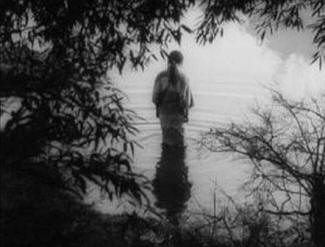Postwar Japanese Film
 Like
elsewhere, there was strong censorship before and during WW II. Censorship continued during the American
occupation (1945-52), though it became less strict after 1949.
Like
elsewhere, there was strong censorship before and during WW II. Censorship continued during the American
occupation (1945-52), though it became less strict after 1949.
As in the US, there were independent competing studios. There were four "majors," each associated with an
important director*.
Directors took on a strong popular role and were widely known among the general public. They, as much (or even more) than stars were key box office attractions.
Next: Akira Kurosawa
 Here are the four major Japanese studios and the directors with which they are associated:
Here are the four major Japanese studios and the directors with which they are associated:
Nikkatsu, with Kon Ichikawa;
Shochiku, associated with Yasujiro Ozu;
ToHo, associated with Akira Kurosawa (and with Godzilla pictures);
Daiei (later Kadokawa), associated with Kenji Mizoguchi].
Like American film, Japanese film has genres and stock characters, but they are different than Western film. Some of these include:
Jidai-geki are genre films. Jidai-geki "proper" are costume dramas of the Tokugawa era (1615-1868)
sub-genres treat other eras (for example Meiji-mono
treats 1868-1912)
Gendai-geki are genre films of modern life.
Sub-genres include middle-class drama or comedy, mother picture,
wife picture, non-sense picture, gangster picture, youth
picture, J-horror...
Tateyaku is a male stock character: modeled on the ideal samurai; the stoic man of few words who choses loyalty above all.
Nimaime is a male stock character: an undependable often pathetic character but also one who through dependence on others denies heroism and advocates mutual cooperation.
 Like
elsewhere, there was strong censorship before and during WW II. Censorship continued during the American
occupation (1945-52), though it became less strict after 1949.
Like
elsewhere, there was strong censorship before and during WW II. Censorship continued during the American
occupation (1945-52), though it became less strict after 1949. Here are the four major Japanese studios and the directors with which they are associated:
Here are the four major Japanese studios and the directors with which they are associated: